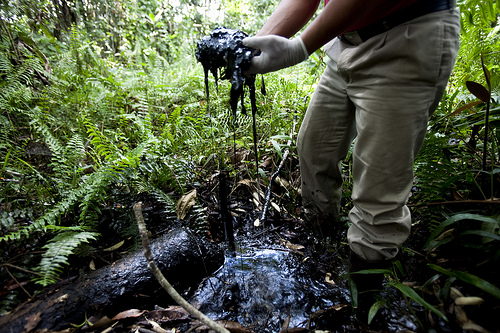 Shockwaves rippled through the world’s largest environmental lawsuit today. A new damages assessment has been submitted in the lawsuit pitting 30,000 Indigenous peoples and local farmers against the global oil giant Chevron.
Shockwaves rippled through the world’s largest environmental lawsuit today. A new damages assessment has been submitted in the lawsuit pitting 30,000 Indigenous peoples and local farmers against the global oil giant Chevron.
The damages assessment finds that because of factors still persisting in the Ecuadorean rainforest from Chevron’s pollution, nearly 10,000 Ecuadoreans are at significant risk of dying from cancer by the year 2080, even if Chevron cleans up the toxic contamination in the next ten years.
“The information in this submission is highly significant because it reflects clearly that there is a terrible oil-related disaster in Ecuador in the area where Chevron operated,” said Pablo Fajardo, lead lawyer for the Amazon communities. “What these analyses make chillingly clear is that thousands of Ecuadorean citizens may well contract and die of cancer in the coming decades because of Chevron’s contamination,” he added.
This new round of assessments comes after complaints by Chevron about the original independent assessment, submitted in 2008 – which contained over 105 expert reports and more than 64,000 samples, many of which came from Chevron’s own team. Since the original assessment Chevron has invested in public relations campaigns, spy schemes, and fake media reports in an attempt to discredit the assessment, smear highly respected scientists, and derail the lawsuit.
Then recently, in a move seemly to appease Chevron, the presiding judge opened a 45-day window for both parties to submit their own damage assessments to the court. Had Chevron the basis to prove there is no contamination in Ecuador’s rainforest, the company would have pounced on the opportunity. But it didn’t. Instead, Chevron immediately rejected the court’s offer to compile and submit a damages assessment. Many in the legal and human rights communities found this move irreconcilable. However, those close to the lawsuit see this latest development as yet another indicator that Chevron is solely interested in delaying the trial, rather than letting the court rule on the facts of the case.
“We predict that Chevron’s bad faith will be on full display yet again. Chevron complained that it did not have an opportunity to produce its own damages assessment. But when given the opportunity, company lawyers accuse the judge of bias against Chevron and launch attacks on the justice system.” Said Fajardo
Six renowned technical and medical experts compiled the new damages assessment. Based on their findings, the damages reached $40 to 90 billion, nearly double the $27.3 billion originally determined. (The numbers are broken down in the court filing that can be found HERE.) The new numbers come after a new and more thorough examination of Chevron’s “unjust enrichment” – money saved by using sub-standard drilling practices. While operating in the region the oil company intentionally used drilling practices deficient in safety and pollution safeguards. Simply, Chevron is accused of intentionally poisoning communities to save a buck.

It’s obvious that Chevron never had any intention of submitting a new report, its intention was to be obstructionist – resigned to the fact that anything found in any assessment will only point to the company’s liability. Chevron’s game-plan is clear: delay the trial at any cost, all the while communities continue to suffer from the pollution. As a recent DowJones article points out, Chevron won’t be able to do this forever. The end of this precedent setting trial is nearing. The entire oil industry is watching this lawsuit with guarded eye, as it will potentially set the stage for similar suits – demanding restitution for harm and negligence. It is because of this that Chevron will pull no punches as the company tries to claw its way from liability. Expect more fireworks and distraction from Chevron, as the truth continues to pin the company in a corner of accountability.